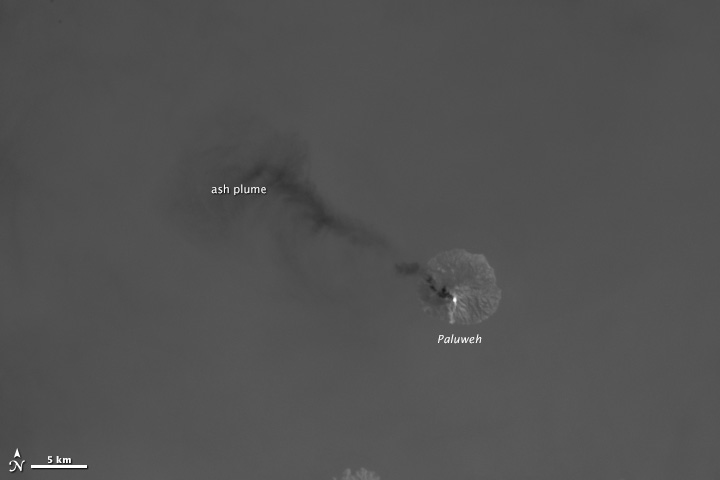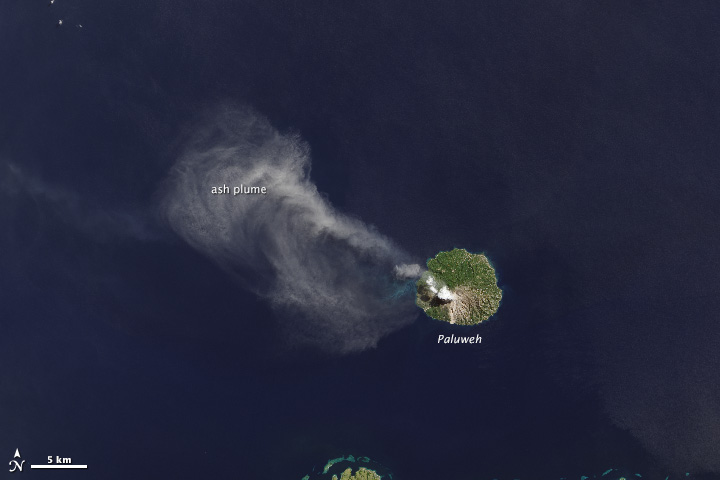acquired April 29, 2013
download large image (13 MB, JPEG, 15001x14541)
acquired April 29, 2013
download GeoTIFF file (197 MB, TIFF)

acquired April 29, 2013
download large image (300 KB, JPEG, 2511x2431)
acquired April 29, 2013
download GeoTIFF file (1 MB, TIFF)
acquired April 29, 2013
download Google Earth file (KML)
As the Landsat Data Continuity Mission
(LDCM) flew over Indonesia’s Flores Sea on April 29, 2013, the
satellite’s Operational Land Imager (OLI) captured a natural-color image
of Paluweh volcano spewing ash (top). The Thermal Infrared Sensor (TIRS) on LDCM got a different view of the same event (bottom).
Observing the heat emanating from the five-mile-wide volcanic island,
TIRS revealed a hot spot where lava was oozing near the top of the
volcano. The sensor also showed the coolness of the ash relative to the
warmth of the tropical ocean surface below, as the darker hue of the
plume represents cooler temperatures.
To Betsy Forsbacka, the combination of the two LDCM instruments
illustrates an insight first attributed to Aristotle: The whole is
greater than the sum of its parts. “Each instrument by itself is
magnificent,” said Forsbacka, TIRS instrument manager at NASA’s Goddard
Space Flight Center. “When you put them together, with the clues that
each give you about Earth’s surface, it’s greater than either could do
by themselves.”
The LDCM team is excited about TIRS because it has ability to capture
the sharp boundary between hot lava and cooler volcanic ash without the
signal from the hot spot bleeding over into pixels of the cooler areas.
TIRS engineers tested and refined the instrument before launch to
ensure that each pixel correctly represents the heat source it images.
Otherwise, Forsbacka said, looking at hot spots would be like shining a
flashlight in your eyes; the bright light makes you see spots and halos
where it should be dark. The same effect can occur with satellite
detectors.
TIRS also can detect subtle shifts in temperature—within a tenth of a
degree Celsius. With two different thermal bands (instead of one, like previous Landsat sensors), LDCM should make it easier for scientists to get a more accurate temperature of Earth’s surface. Observing land surface temperatures
from space can be difficult because moisture and particles in the
atmosphere can slightly alter thermal signals. With TIRS, the atmosphere
affects each thermal band slightly differently, resulting in one
thermal image that’s a hair darker than the other. By measuring that
difference and plugging it into image-analysis algorithms, scientists
can better address atmospheric effects and create a more accurate
temperature record of the Earth’s surface.
Further Reading
- NASA Earth Observatory (2013, April 16) Eye Exam for a Satellite.
- NASA Earth Observatory (2012, July 23) Landsat Looks and Sees.
- NASA Landsat Data Continuity Mission. Accessed May 6, 2013.
- NASA The Landsat Program. Accessed May 6, 2013.
Images by Robert Simmon, using data from the U.S. Geological Survey and NASA. Caption by Kate Ramsayer and Mike Carlowicz.
- Instrument:
- Landsat 8
NASA: Indonesia - Flores Sea - Thermal Sensor Lights Up from Volcanic Heat - 10.05.13
Ricardo M Marcenaro - Facebook
Blogs in operation of The Solitary Dog:
Solitary Dog Sculptor:
byricardomarcenaro.blogspot.com
Solitary Dog Sculptor I:
byricardomarcenaroi.blogspot.com/
Para:
comunicarse conmigo
comunicarse conmigo
marcenaroescultor@gmail.com
For:
contact me
For:
contact me
marcenaroescultor@gmail.com
My blogs are an open house to all cultures, religions and countries. Be a follower if you like it, with this action you are building a new culture of tolerance, open mind and heart for peace, love and human respect. Thanks :)
Mis blogs son una casa abierta a todas las culturas, religiones y países. Se un seguidor si quieres, con esta acción usted está construyendo una nueva cultura de la tolerancia, la mente y el corazón abiertos para la paz, el amor y el respeto humano. Gracias:)
(::)


No hay comentarios:
Publicar un comentario